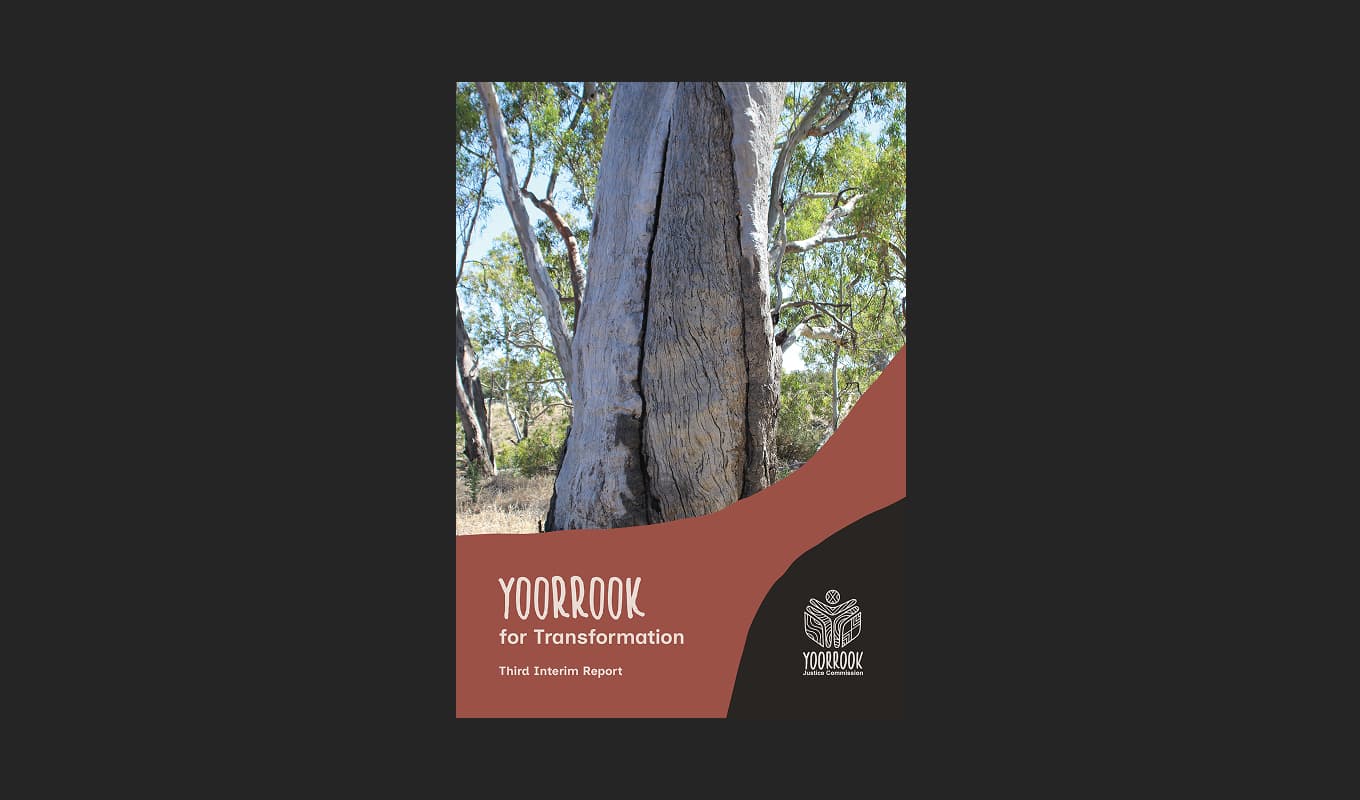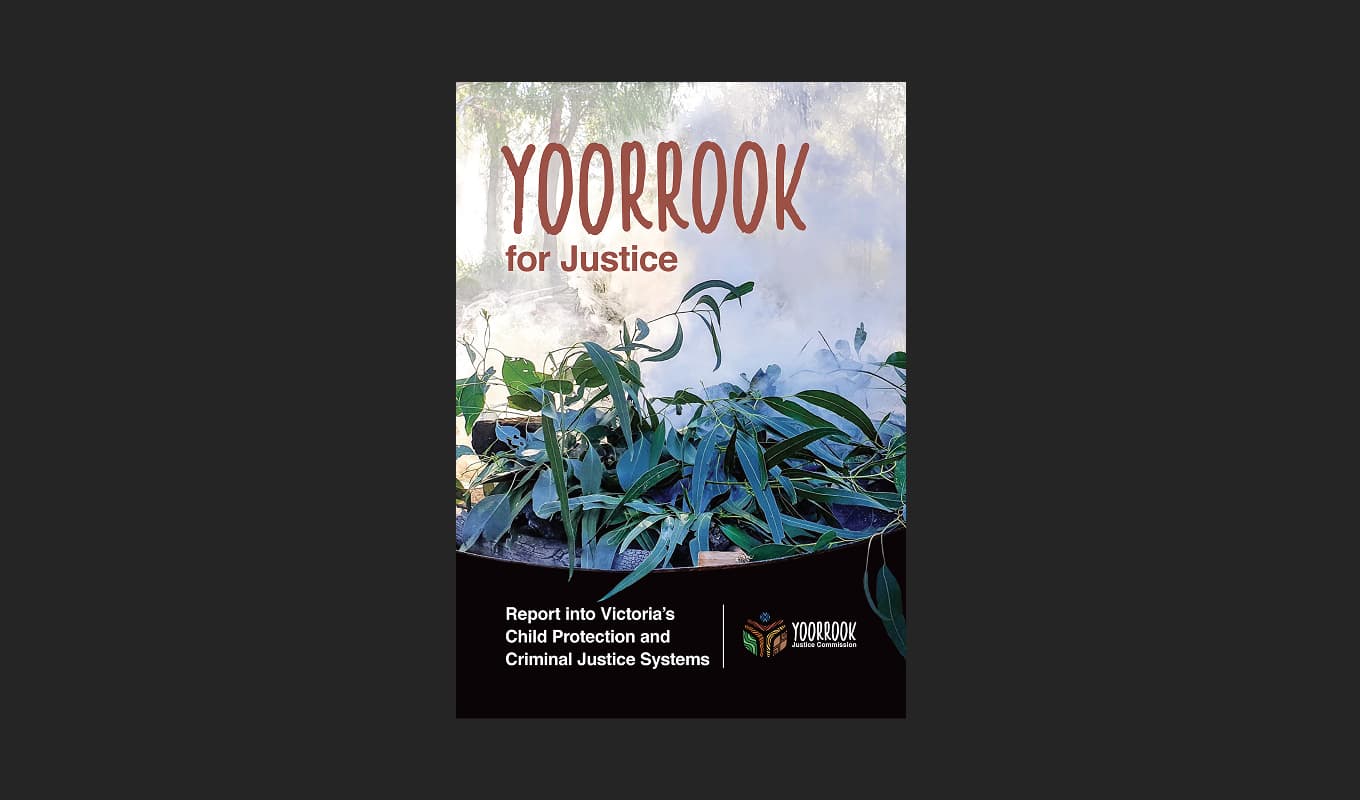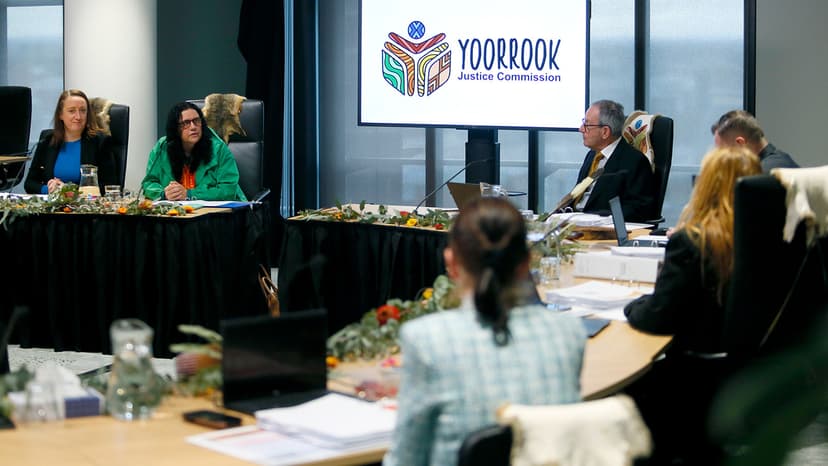Economic Prosperity
Before colonisation, First Peoples had thriving economies. Since invasion, systemic exclusion has limited access to economic prosperity. Yoorrook heard self-determination is key to economic justice.
This page has been adapted from the Yoorrook Justice Commission reports, which are fully referenced. For referenced information please view the reports linked on this page.
sensitive material warning
Please be aware that this page may contain sensitive material. Read our self care guidelines to help manage any feelings of distress.
Economic Prosperity for First Peoples in Victoria
These economies included sustainable land and resource management practices and extensive trade networks that sustained complex and evolving societies.
Since invasion, First Peoples have been excluded from economic markets and prosperity in Victoria. Land theft, forced relocation to missions, control of labour and wage theft decimated First Peoples’ economic systems. Colonial systems have consistently prevented First Peoples from participating in economic life and wealth creation, including from education, employment opportunities and owning property.
Today, employment and income disparities are influenced by broader social injustice in the areas of education, healthcare and housing. First Peoples continue to face structural barriers to workforce participation, including racism and culturally unsafe workplaces. Further, despite the integral role Traditional Owner groups and First Peoples organisations, businesses and enterprises play in delivering economic prosperity, barriers persist and the First Peoples business sector remains largely unsupported.
Yoorrook heard that self-determination is central to addressing economic injustice. Self-determination over economic development may take different forms, including the establishment and support of First Peoples businesses, commercial use of land, housing development, home ownership and the creation of a capital fund to enable First Peoples’ participation in capital markets as investors.
On this page you will find some of the responses Yoorrook has received as part of its inquiry into economic prosperity.
Economic Prosperity Timeline
Prior to colonisation, First Peoples had thriving economies, including extensive trade networks. First Peoples’ economies were disrupted by colonisation, including through theft of land and resources, forced labour, control of property and stolen wages. Explore the timeline below to learn more.
Establishment of the Port Phillip Aboriginal Protectorate
The British Government, through the Colonial Office, established the Port Phillip Aboriginal Protectorate in the Port Phillip district. ‘Protectors’ distributed rations such as flour and blankets in return for unpaid labour a to those who were sick and to children who attended schools at the Protectorate stations. The New South Wales government closed the protectorate in 1849.
Establishment of the Central Board
The Colonial Government established the Central Board appointed to watch over the Interests of the Aborigines. The Central Board established reserves and a rationing scheme to supply First Peoples off the reserves through a system of Honorary Correspondents across the colony (until this ended in 1904).
Passing of the Aborigines Protection Act 1869
The Colonial Government passed an Act to provide for the Protection and Management of the Aboriginal Natives [sic] of Victoria (more commonly referred to as the Aborigines Protection Act 1869 (Vic)) The Act established the Board for the Protection of the Aborigines (BPA). The government, through the BPA, controlled where First Peoples lived and worked, the condition of their employment and where their wages were paid. From 1871 work certificates were introduced for First Peoples who wished to work off reserves. These controls remained in place until 1957.
Passing of the Neglected and Criminal Children’s Amendment Act 1874
The Colonial Government passed the Neglected and Criminal Children’s Amendment Act 1874 (Vic). First Peoples children who were considered ‘neglected’ were detained until 16 and apprenticed out for work.
First Peoples at Coranderrk receive partial wages as unpaid and underpaid labour
After protests First Peoples living at Coranderrk received wages for growing hops. However, they only receive one-third of the non-Indigenous rate. The proceeds from selling the hops were taken by the BPA. During the 1870-80s, First Peoples were employed to build and maintain reserves and missions, including ‘clearing, building, fencing and farming on the reserves’ and this work ‘was often a requirement for Indigenous people to receive rations’. However, often Aboriginal people received ‘little or no pay’. ‘At Framlingham, Indigenous people working between 1869 and 1877, and for periods after 1877, received no wages.’
Royal Commission recommends all First Peoples working on reserves are paid
The Colonial Government established a Royal Commission regarding the ‘present condition’ of First Peoples in the colony. The Commissioners recommended all First Peoples working on reserves be paid and that the reserve managers have control over the employment conditions and wages of First Peoples working on or off reserves.
BPA Members recommend 'Small Wages' for 'Full-Blooded' First Peoples
The BPA members appointed to the Inquiry into Coranderrk Aboriginal Station recommended ‘small wages’ be paid to ‘full-blooded’ First Peoples working on reserves to help develop a ‘work ethic’ and the apprenticing out of First Peoples of mixed parentage over 13 years of age.
Passing of the Aborigines Protection Act 1886
The Colonial Government passed the Aborigines Protection Act 1886 (Vic). The government used the Act and the new definition to reduce spending on First Peoples. Regulations made under this Act allowed reserve managers to apprentice First Peoples over the age of 13. As a result many boys were apprenticed to farms and girls were sent to work as domestic servants.
Neglected Children’s Act 1887 (Vic) allows the Government to take wages earned by children
The Neglected Children’s Act 1887 (Vic) included sections relating to the employment and wages of children. The Colonial Government passed the Act allowing it to take the wages earned by children covered by this Act and pay them into the State Wards’ Fund. The government used such funds to cover costs incurred by the State and withheld children’s access to funds for ‘misbehaviour’.
Economic depression stops rations and supplies to First Peoples
During the 1890s an economic depression impacted Australia. As legislated in the Aborigines Protection Act 1886 rations and supplies for First Peoples of mixed parentage forced off reserves stopped during this time.
Wages of ‘Half-Caste’ Children controlled and withheld by BPA Inspector
The wages of ‘half caste’ children who had been licensed or apprenticed out for work had to be paid to the Inspector of the BPA, who was then supposed to place that money into a bank account for the child, paying them half quarterly and half at the end of their service.
Aborigines Act 1890 Expands BPA Control Over Wages, Employment, and Children
The Colonial Government passed the Aborigines Act 1890 (Vic). Under this Act the BPA were authorised to enter into contracts for the employment of First Peoples, determine where wages were directed (e.g. third parties), and remove ‘neglected’ children to reserves or industrial or reformatory schools.
Exclusion of First Peoples from Pensions
The Australian Government passed the Invalid and Old-age Pensions Act 1908 (Cth) which excluded First Peoples across Australia from accessing invalid and old-age pensions.
Exclusion of First Peoples from Maternity Allowances
The Australian Government passed the Maternity Allowance Act 1912 (Cth) which excluded ‘full blood’ First Peoples.
Enforcement of strict controls over employment and wages
Regulations made by the Executive Council of the Victorian Government under the Aborigines Act 1915 (Vic) ‘enforced strict controls over Indigenous peoples living on reserves, including over their employment and wages’.
BPA Enforces Relocation to Lake Tyers to Cut Costs and Seize Reserve Land
The BPA attempted to complete its policy to ‘concentrate’ First Peoples at one reserve, forcing residents to move to Lake Tyers. Some residents remained at Framlingham, Lake Condah and Coranderrk despite relocation attempts. The Victorian Government used this ‘concentration’ to reduce spending on First Peoples and sell, lease out and use land from the reserves for other purposes.
Reserve Land Taken for Soldier Settlement Under 1917 Act
The Victorian Government passed the Discharged Soldier Settlement Act 1917 which ‘provided for the selling or leasing of freehold land, acquired compulsorily or by agreement, from its owners, or Crown land, to returned soldiers from World War I through a closer settlement scheme.’ The BPA offered First Peoples reserve land to the government for the scheme.
First Peoples Excluded in Practice from Soldiers’ Repatriation Benefits
The Australian Government passed the Australian Soldiers Repatriation Act 1920 (Cth) and subsequent legislation regarding war and service pensions. The government did not explicitly exclude First Peoples, however the discriminatory administration of the Act excluded First Peoples in practice.
BPA closes Coranderrk
The BPA, with government approval, closed Coranderrk.
BPA Restricts First Peoples’ Earnings from Tourists at Lake Tyers
Report on the Lake Tyers Aboriginal Station found ‘there are few people actually working’ because ‘the Aboriginals can make money too easy elsewhere’ for example selling goods to tourists and recommended ‘tourists be requested to buy nothing direct from the Aboriginals’. This was an ongoing tension during the 1910s to the 1940s, with the BPA and Lake Tyers’ managers attempting to restrict tourist visits and in 1930 the BPA ‘ordered’ money from sales to be put in the reserve income, rather than the artist or creator.
1928 Act Continues Government Control Over First Peoples’ Children’s Wages
The Victorian Government passed the Children's Welfare Act 1928 (Vic). The Act controlled children’s wages similarly to the earlier versions of the Neglected Children’s Act (Vic).
The Great Depression begins
Aborigines Board Produce Fund Controls Earnings and Wages from First Peoples
The Executive Council of the Victorian Government established the Aborigines Board Produce Fund under regulations in relation to the Aborigines Act 1928 (Vic). Monies earned from the labour of First Peoples, such as through the cultivation of grains and vegetables, sale of stock reared by residents, leasing of reserve land and contracts for wattle bark and timber, were paid into the fund. The BPA could ‘from time to time…pay to the [First Peoples] who have laboured on reserves such sums as it may determine’. The BPA used the money also for buying stock, material and other goods. The BPA and reserve manager determined the wages of First Peoples.
Cummeragunja walk-off
Residents at Cummeragunja Mission walk off due to the poor living conditions, mismanagement of land and harsh treatment.
1942 Acts Allow Limited, Unequal Access to Pensions and Maternity Allowances for First Peoples
The Australian Government passed the Maternity Allowance Act 1942 (Cth). The amended Act opened the potential for some First Peoples to access it, but with strict criteria – they needed to be exempt from legislation controlling the lives of First Peoples in the state or territory in which they lived.
The Australian Government passed the Invalid and Old Age Pension Act 1942 (Cth) amending earlier versions of the Act to make some First Peoples able to access the pension in certain circumstances. First Peoples eligible for the pension were to be paid less than non-Indigenous people and the Commissioner could direct for the pension to be paid to a third party.
Soldier Settlement Act Enables Compulsory Land Acquisition in Victoria
The Victorian Government passed the Soldier Settlement Act 1945 allowing the compulsory acquisition of land for soldier settlement.
Coranderrk Land is sold for soldier settlement
The permanent status of Coranderrk was revoked by the Victorian Government through the passing of the Coranderrk Lands Bill 1948 (Vic). Aside from the cemetery, the land at Coranderrk was sold by the Lands Department for soldier settlement following World War 2.
Lake Condah Mission Site mostly sold
The Lands Department sold most of the Lake Condah mission site, except the cemetery, an access road and the mission buildings, through the Soldiers Settlement Commission.
Aborigines Act 1957 Replaces BPA with AWB and Expands Control Amid Calls for Assimilation
Charles McLean released the Report upon the Operation of the Aborigines Act 1928. During his inquiry he found ‘racial prejudice from the wider Victorian community adversely impacted upon Indigenous employment’. McLean called for a change to government policy to assimilation.
The Victorian Government passed the Aborigines Act 1957 (Vic). The government established the Aborigines Welfare Board (AWB) through the Act, replacing the BPA and broadening its control to anyone of Aboriginal descent. The government gave the AWB the power to prescribe conditions of employment where an industrial award did not already prescribe them – this included prescribing housing in relation to employment. The Aborigines Board Produce Fund was closed and monies transferred to the newly formed Aborigines Welfare Fund, housed within Treasury. Money raised from reserves was paid into the Fund and used to pay AWB expenses.
Regulations Enforce Mandatory Labour and Residency Controls
Regulations made under the Aborigines Act 1957 (Vic) required all ‘able bodied people’ on reserves to perform ‘a reasonable amount of work’ with any remuneration determined by the manager on AWB approval (unless an industrial award was applicable). First Peoples’ living on reserves could be fined for misconduct and the AWB could deny or revoke a person’s permit to live on a reserve, forcing them to leave.
Social Services Act Extends Pensions but Excludes ‘Nomadic or Primitive’ First Peoples.
The Australian Government passed the Social Services Act 1959 (Cth). Whilst passing of the Act allowed more First Peoples to access invalid and old-age pensions, First Peoples considered to live a ‘nomadic or primitive’ life ‘in the opinion of the Director-General’ could not access any form of pension, benefit, endowment or allowance under the Act.
Creation of Ministry of Aboriginal Affairs in Victoria.
The Victorian Government passed the Aboriginal Affairs Act 1967 (Vic) which abolished the AWB, instead forming the Ministry of Aboriginal Affairs and an Aboriginal Affairs Advisory Council, established to promote ‘social and economic advancement’ of Victorian First Peoples. The Aborigines Welfare Fund was closed and monies transferred to the Aboriginal Affairs Fund.
Amendment allows First Peoples to be employed outside Public Service Act.
The Victorian Government passed the Aboriginal Affairs (Amendment) Act 1968 (Vic). The Act allowed the Ministry of Aboriginal Affairs to employ First Peoples ‘without having to comply with the provisions of the Public Service Act’.
Committee Recommends Compensation for Victorian Traditional Owners’ Land Dispossession.
The Victorian Government established a Parliamentary Committee ‘to report on compensation for the dispossession of Victorian Traditional Owners.’ In 1984 the Committee recommended that the ‘land rights issue’ could not be resolved without providing compensation to Traditional Owners and proposed a minimum annual amount of $5 million from Victorian and Federal Government revenue as compensation. The Government provided in principle support but proposals in the Aboriginal Land Claims Bill 1983 (Vic) were not revived.
Indigenous Business Australia and Aboriginal and Torres Strait Islander Commission (ATSIC) created
Bringing Them Home report
The Bringing Them Home report identified the economic injustice faced by First Peoples and ‘recommended that social justice packages should be developed to support our children and families.’ This has never been implemented.
First Nations Credit Union is started in Shepparton
Wur-cum Barra
Department of Natural Resources and Environment Aboriginal Employment Strategy - Wur-cum barra (2000-2005).
Senate Report Exposes Stolen Wages Practices.
First Nations Foundation is created to support the financial skills of First Peoples.
Commonwealth Senate Standing Committee on Legal and Constitutional Affairs report Unfinished Business: Indigenous Stolen Wages published. The report identified systemic government practices of withholding and mismanaging First Peoples’ wages and entitlements that occurred until the 1980s.
Supply Nation established
Strategy and Equal Opportunity Act Promote Aboriginal Employment and Inclusion.
Department of Innovation, Industry and Regional Development Aboriginal Employment Strategy - Karreeta Yirramboi (2010-2015).
The Victorian Government passed the Equal Opportunity Act 2010 (Vic) for positive affirmation strategies including identified Aboriginal positions.
Kaiela Institute established
Kaiela Institute for Leadership and Innovation established (combines Koori Resource and Information Centre (KRIC) and Shepparton Policy and Planning Unit (SPPU))
Victorian Aboriginal Economic Strategy Launched
The Victorian Government launched its Victorian Aboriginal Economic Strategy (2013-2020).
Chamber of Commerce
Kinaway Chamber of Commerce established (incorporated 12 June 2014).
First Australians Capital
Indigenous company, First Australians Capital was established.
Victoria’s first Aboriginal Economic Board Appointed
The Victorian government announced the appointment of Victoria’s first Aboriginal Economic Board in 2016, to be co-chaired by Karen Milward and Mark Stone.
Introduction of Aboriginal Business Supports
Barring Djinang Aboriginal Employment Strategy (2017-2022) was introduced. This was later updated in 2024 to Barring Djinang (2024-2028).
Tharamaba Bugheen – Victorian Aboriginal Business Strategy 2017-2021
Ngarrimili established to support First Nations businesses and entrepreneurship.
Vic Social Procurement Framework
Victorian Government’s Social Procurement Framework established.
Employment and Economic Strategy launched
Victorian Government, Yuma Yirramboi (Invest in Tomorrow) Victorian Aboriginal Employment and Economic Strategy launched.
Economic Prosperity Timeline
Prior to colonisation, First Peoples had thriving economies, including extensive trade networks. First Peoples’ economies were disrupted by colonisation, including through theft of land and resources, forced labour, control of property and stolen wages. Explore the timeline below to learn more.
Key Statistics
In 2022–23, Victorian Aboriginal businesses generated $1.05 billion in revenue and contributed $520.6 million in gross value added to the state economy. While there have been signs of progress, significant gaps remain in income, employment, workplace treatment, and economic inclusion.
These disparities are underpinned by systemic barriers that continue to limit opportunities for prosperity and self-determination. For instance, First Peoples are less likely to hold higher-earning occupations than non-First Peoples.
In 2021, the median weekly personal income for First Peoples in Victoria was $619, compared to $803 for the general population.
Employment for First Peoples aged 25–64 increased from 57.3% in 2016 to 62% in 2021, but remains below the 78.4% employment rate for non-First Peoples.
A 2020 national survey found 38% of First Nations workers reported being treated unfairly due to their Indigenous background
The 2020 national survey also found 44% of First Nations workers had heard racial slurs at work
That same 2020 survey found 59% of First Nations workers experienced racism related to their appearance
In 2021–22, First Nations businesses accounted for only 0.7% of state small-to-medium enterprise purchase agreements (valued at $21.6 million).
Colonial wealth was achieved through the control of First Peoples labour and land.
European colonisers’ intent to make wealth drove them to take First Peoples’ land and resources. Confinement on missions and reserves continued to exclude First Peoples from the possibility of economic prosperity. The State also stole First Peoples’ income used First Peoples children for child labour.
Economic disparities persist today
Today, First Peoples in Victoria experience inequity in a range of economic outcomes. Long-term denial of economic supports and opportunities drives First Peoples’ poverty. While the descendants of settlers have generated intergenerational wealth from First Peoples’ lands and resources.
First Peoples face unique barriers to employment, business and access to capital
First Peoples in Victoria experience barriers to employment, are employed in lower paying jobs and industries, and have lower wages than non-First Peoples in Victoria. First Peoples continue to face structural barriers to workforce participation, including racism, culturally unsafe workplaces and cultural load in the workplace. Despite their strengths, First Peoples businesses face state-imposed barriers to success including disadvantaged in any resourcing, grant or procurement processes due to onerous application processes and a lack of existing assets and capital.
Self-determination supports economic equity
Yoorrook heard evidence that First Peoples must have decision-making power over the distribution of financial resources in order to achieve economic equality. Generational prosperity requires the removal of barrier to employment, support of First Peoples business and greater access to capital and assets.
Submissions and evidence related to economic prosperity
Economic disparities reflect a colonial legacy
Yoorrook heard evidence that the legacy of dispossession and exclusion from colonial economics continues to impact First Peoples in Victoria.
Systemic barriers to economic prosperity
Social injustices compound economic disparities in First Peoples economic participation.
Ensuring ongoing prosperity
The First Peoples business sector in Victoria demonstrates remarkable success despite facing unique barriers and a lack of support. Yoorrook heard evidence that investment in the First Peoples business sector is essential to future economic prosperity.
Economic self-determination
First Peoples must be empowered to build their economic prosperity through self-determination.
Supporting First Peoples in Work and Business
The State has a responsibility to remove barriers to workforce participation and invest in the growth of the First Peoples business sector.
Hearings held about economic prosperity
The First Peoples business sector continues to grow, with leaders highlighting its success despite ongoing systemic challenges. They identified key supports needed for future growth. State representatives acknowledged the historical roots of economic disparity and affirmed the government’s responsibility to support First Peoples in the workforce, public sector, and business.
Public Hearings: 24 June – 26 June 2024
The purpose of these hearings was to gather evidence from the Treasurer, Minister for Housing and representatives of First Nations businesses in Victo... more
Speaking Truth: Barriers to Economic Prosperity
First Peoples leaders and community members share their experiences of economic injustice—from intergenerational wealth inequality to inconsistent support for business and systemic exclusion from opportunity.
Submission - Jennifer Mason & Lowanna Moore
Jennifer Mason is a Wamba Wamba and Dhudhuroa woman. Lowanna Moore is a Wamba Wamba descendant.
In this video submission, they discuss how First Peoples’ history could be better taught in schools through empowering culture. They reflect on barriers in the education system for Aboriginal people, self-determination, and the effect of the loss of land on intergenerational wealth.
Economic prosperity recommendations
Explore some of the recommendations made in Yoorrook for Transformation on economic prosperity.
The Victorian Government must assist recruitment, development, and retention of First Peoples in the workplace by:
(a) Amending the Occupational Health and Safety Act 2004 (Vic) to include an obligation on employers and employees to take steps to ensure cultural safety and capability in Victorian workplaces.
(b) Creating a pipeline of First Peoples talent for identified industries with skills shortages, including bolstering access to education and vocational training for First Peoples to prepare them for high-value employment sectors.
(c) Monitoring and ensuring proper pay and conditions against defined targets for First Peoples in the public sector.
(d) Monitoring and ensuring proper remuneration for the cultural load borne by First Peoples in the workplace.
(e) Ensure the private sector develops recruitment, development, mentoring and retention strategies for First Peoples and support the private sector in developing such strategies
The Victorian Government must take steps to ensure increased First Peoples representation on both company and government boards through improved accountability and transparency measures, including requirements to publicly disclose board diversity and report annually on First Peoples representation.
The Victorian Government must ensure that the Self-Determination Fund is adequately resourced on a guaranteed, ongoing basis to meet its current and future purposes.
The Victorian Government must negotiate with First Peoples to establish a capital fund, through the Self-Determination Fund or other means, to enable investment by First Peoples and First Peoples organisations in capital markets and other initiatives to promote economic prosperity.
Explore other Focus Areas
The issues explored by Yoorrook are deeply connected—experiences in one area often impact outcomes in many others. Continue exploring the broader picture by visiting other Focus Areas below.
Support Resources
If you feel overwhelmed you can call 13 YARN (13 92 76) or Lifeline (13 11 44) for confidential support. For additional support options, visit support resources.
Reports and Recommendations
Read the official reports and recommendations of the Yoorrook Justice Commission.

Yoorrook for Transformation
Third Interim Report: A five-volume comprehensive reform report presenting evidence and findings on systemic injustices, and specific recommendations for meaningful change to transform the future.

Truth Be Told
An official public record that documents First Peoples experiences since colonisation, preserves crucial testimonies for future generations and creates an enduring resource for education and understanding.

Recommendations for change
Yoorrook Justice Commission’s recommendations for truth-telling, justice, and systemic reform in Victoria.

